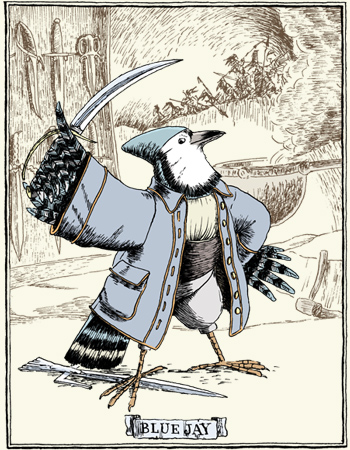 Captain Blue Jay, notorious and
feared pirate of the skies, has a fondness for collecting treasure,
especially eggs. Unfortunately, sometimes his treasure hatches, and this
time the hatchling is the strangest one the Grosbeak has ever
seen. No sailor is certain whether the chick is a young god or just an
oversized bird who needs too much food, but one thing is clear: the
winds over Thrushland are shifting, and dramatic changes are in store
for all.
Captain Blue Jay, notorious and
feared pirate of the skies, has a fondness for collecting treasure,
especially eggs. Unfortunately, sometimes his treasure hatches, and this
time the hatchling is the strangest one the Grosbeak has ever
seen. No sailor is certain whether the chick is a young god or just an
oversized bird who needs too much food, but one thing is clear: the
winds over Thrushland are shifting, and dramatic changes are in store
for all.
Whether outwitting a gang of thieving crows, outrunning
murderous fishers and weasels, or rallying Briarloch’s beleaguered
sparrows, this motley crew must do all they can to stay together and
stay alive. And that’s just the tip of the bird’s feather! Offering a
bounty of illustrations and a host of memorable characters — from an
endearing star-nosed mole to an unlikely little warrior with a vendetta —
here is a treasure for anyone who has ever wanted to take to the skies
and see where fortune blows.
The concept of pirate birds pillaging the skies allowed Nash to create his own unique world full of avian culture. A lot of topics are cleverly addressed, from how ships can sail through the air to what sort of weapons birds would use for fighting and plundering. You can tell that Nash put a lot of thought into carefully crafting each detail that makes up this fantasy bird world, including foods, gods, treasures, clothes, enemies, friends, superstitions, medical remedies, and everything in between. Even the exclamations and insults are a perfect mix of "pirate" and "bird," resulting in some giggle-worthy phrases like, "Shaddup, ya beetle-head or I'll crack yer beak in two!" This careful attention to details and word-choices is so important in creating a fantasy world that readers will love from page one to "The End."
 |
| An example of Nash's beautiful illustrations. |
To paint an even clearer picture of this fantasy world, Nash also incorporates many illustrations in Blue Jay the Pirate. Illustrations aren't standard in middle grade books, and there seems to be a lot of debate on whether or not they are necessary in novels for this age group. In this instance, Nash's wonderful illustrations add a lot to the story. With their pen and ink style and minimal colors, they look just like they belong alongside classic swashbuckling stories like Treasure Island and Robinson Crusoe. While this book could certainly stand alone without the illustrations, the maps, characters, and scenes Nash depicts compliment the words perfectly, giving the story a new depth and extra-piratey feel.
If you're a fan of pirate tales and treasure hunts, then Blue Jay the Pirate is a jolly good book for you. If you write animal fantasy, this is a dandy book to study and one you'll have a hard time putting down, too. And if you are an illustrator, this is a superb book to see how well illustrations can compliment a novel-length story. In short: should you read this book? Aye!
You can find out more about Scott Nash and Captain Blue Jay on his website at: www.bluejaythepirate.com.
And if you read this book, do let me know! I'd love to hear what you think. :)
Happy reading!
Note: The summary blurb and cover picture are from Goodreads; the illustration is from Nash's website, noted above. The cover art and illustration are both (c) Scott Nash.

No comments:
Post a Comment